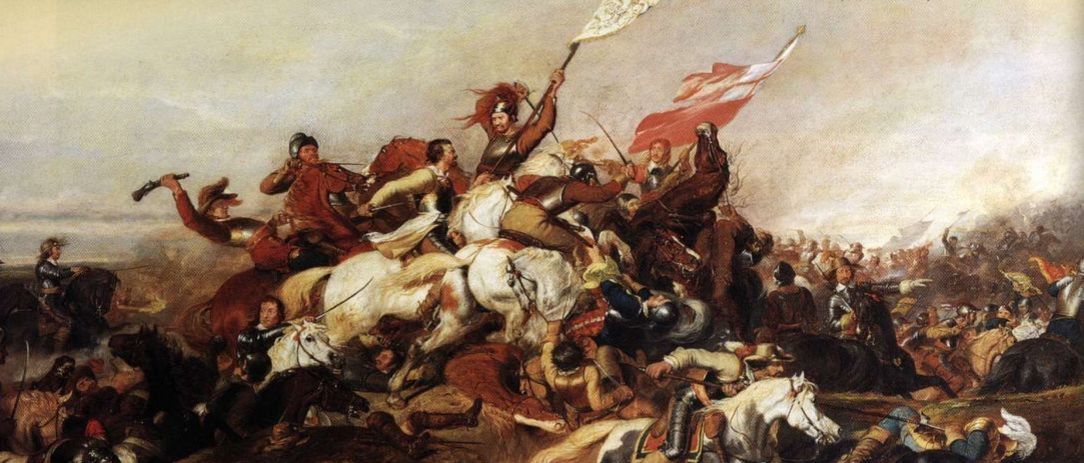Battle of Marston Moor
Posted on 14th January 2021
The North of England except for the stronghold of Manchester, some cloth producing towns and other small pockets of resistance was overwhelmingly Royalist in its sympathies. It, along with Wales, the West Country, and Ireland produced essential supplies and most of the troops for the Royalist Army and its East Coast ports provided a vital lifeline to the Continent across a North Sea dominated by the Parliamentary Navy.
The first two years of the Civil War had gone well for the Royalists and apart from the South-West nowhere more so than in the North.
Their Northern Army was led by William Cavendish the Marquess of Newcastle who had equipped much of it out of his own purse and had proved himself a competent if not outstanding military commander.
On 30 June 1643, the Parliamentary Army under the command of Lord and Sir Thomas Fairfax had been defeated at the Battle of Adwalton Moor and forced to retreat to the port of Hull where they were later besieged; with Parliaments Army safely bottled up Newcastle was looking to take the bulk of his army south to support a planned attack by the King upon London, and he did indeed advance into Lincolnshire with some initial success before circumstances were to force his withdrawal.
In August 1643 however, following a somewhat vague commitment to introduce Presbyterian forms of worship throughout England and to force all men aged over eighteen to take the Oath of Worship or be penalised for not doing so, Parliament in London signed the Solemn League and Covenant with Scotland. For their part the Scots had agreed to send a large army south in support of Parliaments cause.
The Royalist situation in the North had changed almost overnight, with the Scots marching south, the Army of the Eastern Alliance able to advance from Lincolnshire in the East and Parliaments Northern Army still holding out in Hull, the Marquess of Newcastle found himself threatened from three sides. In response he chose to maintain the siege at Hull whilst taking the bulk of his army to delay the Scots advance but there was little, he could do to deter the encroachment of the Eastern Alliance.
The refusal of Hull to yield was proving a thorn in the side of the Royalists. It was not possible to starve them into submission because they were easily re-supplied from the sea and in recent weeks the siege itself had become so loose that Lord and Sir Thomas Fairfax had been able to break through the siege works and carry out vigorous and effective raids on Royalist supply lines.
Newcastle had little choice but to return to Hull and try to force its surrender. On 11 October, a determined effort to storm the city was bloodily repulsed. Made aware that the defenders in Hull were receiving reinforcements from ships docking in port and that the Army of the Eastern Association under the Earl of Manchester and his much talked about Cavalry Commander Oliver Cromwell were closing in on the city, the following day he abandoned the siege.
Newcastle continued to battle on three fronts and though he had successfully delayed the advance of the Scottish Army he had been unable to halt it and by 22 April 1644, they had successfully joined forces with those of Lord Fairfax at Wetherby just 14 miles from York.
The city of York was the hub of Royalist support in the North and a prime target for the Parliamentary, now Allied Army. Its loss would be a serious strategic setback and so Newcastle now withdrew his army behind its walls to await the inevitable siege, but it was clear that if he did not receive support, and soon, he would not be able to maintain control of the North.
At his Court in Oxford the King decided following a meeting of his Council of War that he would sustain his position in and around Oxford from where he could continue to threaten London while Prince Rupert, the Commander of the Royalist Army, would march North to York’s relief with a small force raising more troops as he went.

The campaign began well with Rupert moving quickly and brilliantly outmanoeuvring the superior Parliamentary forces sent to intercept him. He was also making good time and for the most part his troops were warmly received. On 25 May, Stockport fell without a shot being fired and three days later he stormed the town of Bolton where an alleged massacre of 1,200 prisoners and civilians took place. It was an accusation frequently made of Rupert and not one always without foundation.
His reputation for ruthlessness spread fear among his enemies and it was a reputation he willingly exploited. Shortly after his success at Bolton his small army was reinforced by Lord Byron’s cavalry.
Rupert was encountering little resistance on his march north. Indeed, in Wigan its cobbled pavements were strewn with flowers as the townspeople came out onto the streets to cheer his march through. His army was also growing with many local men signing up to the colours some of whom were veteran soldiers though many were also untrained raw recruits whose effectiveness in combat would be negligible. He was soon to be further reinforced by Lord Goring and his cavalry who had escaped the siege at York.
By 8 June, Rupert’s army stood outside the walls of Liverpool which if captured would provide a vital port of entry for reinforcements from Ireland. Liverpool’s Parliamentary Governor John Moore, who would later be one of the Regicides who signed the King’s death warrant, was determined to resist, or so it seemed. He defiantly refused Prince Rupert’s summons for him to surrender and the first attempt to storm the city was repulsed. However, that night under the cover of darkness he evacuated the city be sea.
Rupert’s sense of satisfaction was tempered somewhat by the receipt of bad news from Oxford. In his absence the King had foolishly allowed himself to be persuaded to assign troops to a campaign in the West Country leaving his capital vulnerable to assault and forcing him to seek refuge in Worcester. Rupert who had departed north in haste had never had the objectives, except that is for the immediate relief of York, of his campaign made clear to him. Now upon hearing of the King’s dilemma he was tempted to abandon the campaign and take his army south in his support. His uncertainty regarding the best course of action was muddied even further by a dispatch he received from the King on 19 June. It was ambiguous to say the least:
But now I must give you the true state of my affairs, which, if their condition be such as enforces me to give you more peremptory commands than I would willingly do, you must not take it ill. If York be lost then I will esteem my crown a little less; unless supported by your sudden march to me, and a miraculous conquest in the South before the effects of the Northern power can be found here. But if York be relieved, and you beat the rebel’s army of both kingdoms, which are before it, then (but otherwise not) I may possibly make a shift upon the defensive to spin out time until you come to assist me. Wherefore I command and conjure you, by the duty and affection that I know you bear me, that all new enterprises laid aside, you immediately march according to your first intention, with all the force to the relief of York. But if that be either lost, or have freed themselves from the besiegers, or that for want of powder, you cannot undertake that work, that you immediately march with your whole strength, directly to Worcester to assist me and my army, without which, or you having relieved York by beating the Scots, all the successes you can afterwards have must infallibly be useless onto me.
If he wasn't confused before he certainly was now but after some consideration Rupert determined the letter to mean that he was to relieve York and then seek out and destroy the Parliamentary Army in the field. He wasted no time striking out for York. Travelling from Knaresborough he once again outmanoeuvred the large Parliamentary Army sent to intercept him. On 1 July he arrived outside the city and quickly stormed the much-depleted siege works that surrounded it - the siege of York had been raised.
The Marquess of Newcastle who had earlier seen the bulk of the Parliamentary forces abandon the siege and so was aware that Rupert was closing in sent a letter of congratulation praising him for his campaign and warmly welcoming him to the city. Rupert declined to answer instead sending Lord Goring with a demand for him to immediately join with his army and reprimanding him for not having already done so.
Rupert’s high-handed manner with his subordinates had long been the cause of resentment as was his close personal relationship with the King and the glory that was accorded him over and above all others regardless of the hard fighting they might have endured. It was the source of a whispering campaign against him. Nonetheless, and despite his age, he was only 24, no one could match his ability as a military commander neither did anyone doubt his courage. Even so, the petty squabbles and reluctance on the part of some to cede control to or obey the orders of the prince were to come to the fore during the events at Marston Moor.
None loathed the prince more than the Marquess of Newcastle and his second-in-command Lord Eythin who had served under Rupert on the Continent. Both men would seek to undermine his authority at every turn.
Newcastle arrived at Marston Moor around noon the following day with a small troop of gentlemen cavalry. The bulk of his army he had left at York to pillage the abandoned Parliamentary siege works. Rupert greeted him somewhat sarcastically with the words: "Lord, I wish you had come sooner, but I hope yet that we will have a glorious day." Before reproachfully asking him - and where is the rest of your army?
Rupert was eager to attack the Parliamentary Army at once but both Newcastle and Eythin counselled caution, he should wait for the rest of the army to arrive from York, they said. He in turn, showed them the King’s letter that he understood to mean that he should engage and defeat the enemy at the first opportunity, but he was also aware that he was outnumbered. In fact, he had 17,000 men to Parliaments 22,000 and that was counting the troops from York who were at present absent from the field. Parliament also had twice as many guns and their forces were only likely to increase. For the first and only time in his life, Rupert now hesitated.
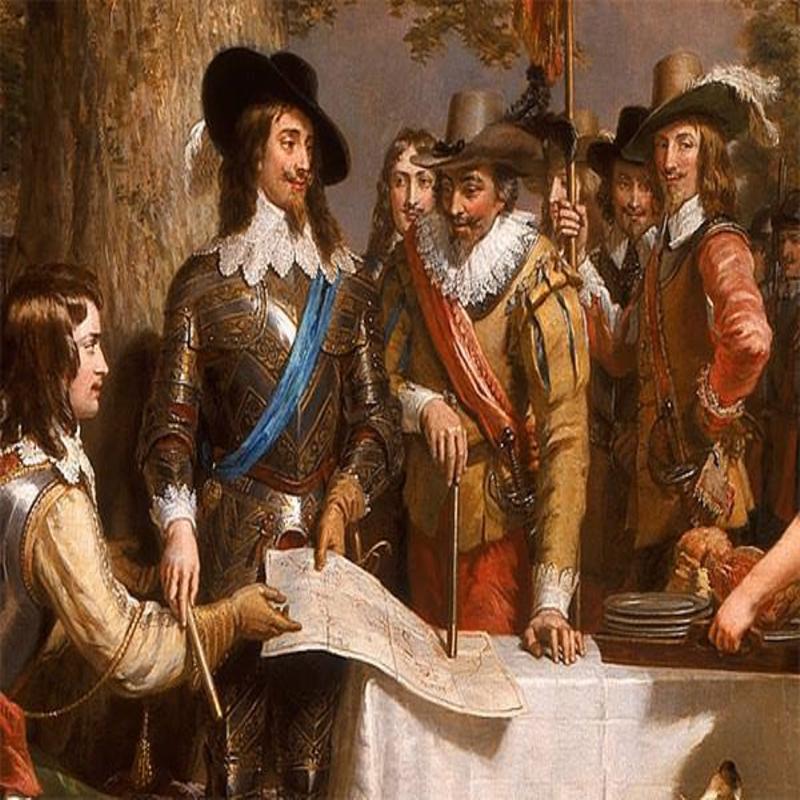
By early evening at least some of the garrison from York had arrived but it was now considered too late in the day to deploy them. Rupert believed that with his army positioned as it was behind a large drainage ditch, he had an effective barrier to any sudden enemy cavalry charge, though how deep, wide, and insurmountable it was has been lost to history, and it is doubtful that it extended the entirety of the Royalist line. Also, the constant bickering between the Royalist commanders had turned acrimonious as Rupert blamed Newcastle and Eythin’s late arrival on the field from preventing him from taking the initiative and they in turn criticised his deployment of the army which had led them to be in no position to begin an attack. The continuing argument over the best course of action had led to little preparation being made for defence. As the hours of indecision ticked by it simply became too late to do anything, or so they thought. They broke up for supper.
From his position at Marston Moor however Rupert could only see the first two lines of the Parliamentary Army the rest were hidden by a depression in the ground. He could not see that they were already formed for battle.
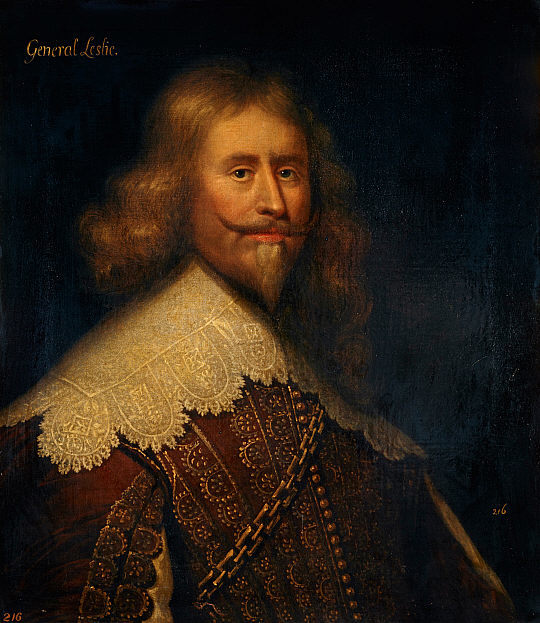
Whilst Rupert sat down to dinner, Alexander Leslie, Lord Leven, in command of the Parliamentary forces could see that the Royalist Army was in some disarray. Even though it was now 7.30 at night and the skies had just darkened as the prelude to a tremendous thunderstorm he ordered a general advance.
Rupert was taken completely by surprise as the balls from the Parliamentary cannon began to rip through his camp even though an indication that an attack was imminent should have been the psalm singing that could be heard just half-a-mile distant but by now a certain complacency or at least lethargy had beset the Royalists, perhaps the result of the endless hours of dispute and uncertainty.
Nevertheless, Rupert was quick to react once the hostilities began but soon found that the orders, he had given earlier in the day had either been forgotten or were ignored in the mayhem.
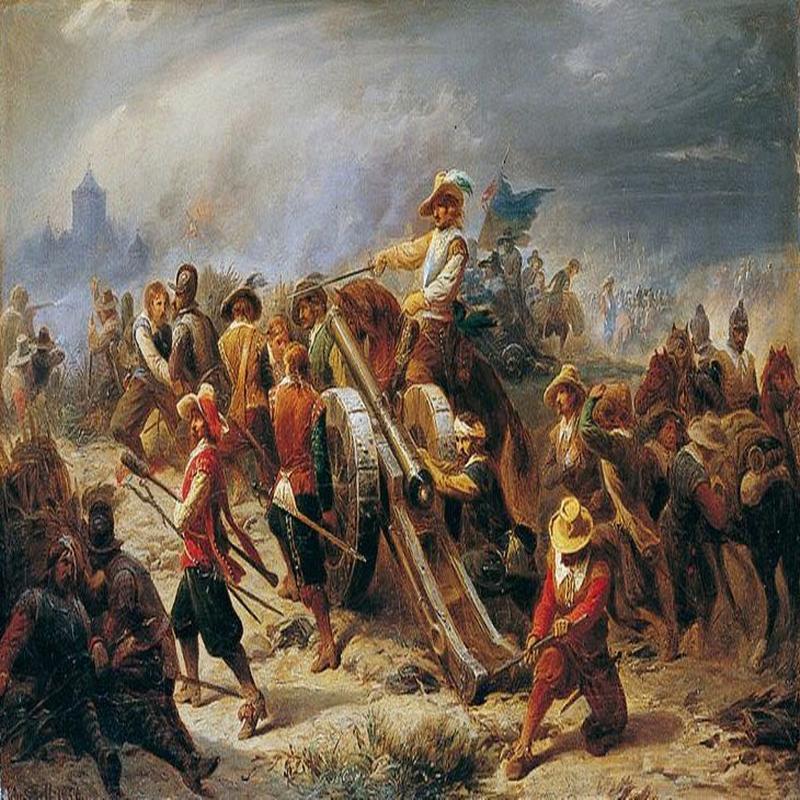
On the Royalist right-wing Lord Byron with 2,600 cavalry and 500 musketeers had been ordered to remain behind the ditch in the event of an enemy attack and let his infantry take the brunt of the assault but his blood was up and as soon as he saw Cromwell’s cavalry advancing towards him, he ordered a counter-charge. It was to be a costly error of judgement. Not only was Byron outnumbered two-to-one but Cromwell’s cavalry were of a different type to his own. They may have lacked the dash and bravura of their enemy, but they were disciplined, manoeuvred as a unit, fought as a unit, and obeyed the orders they were given.
Byron’s men by contrast were brave but were difficult to control and they were only saved from complete annihilation by the prompt arrival of Prince Rupert and his reserve who as Byron’s men began to flee the field took the fight to Cromwell.
A Parliamentary Officer witnessing the charge from afar was to write in the aftermath of the battle:
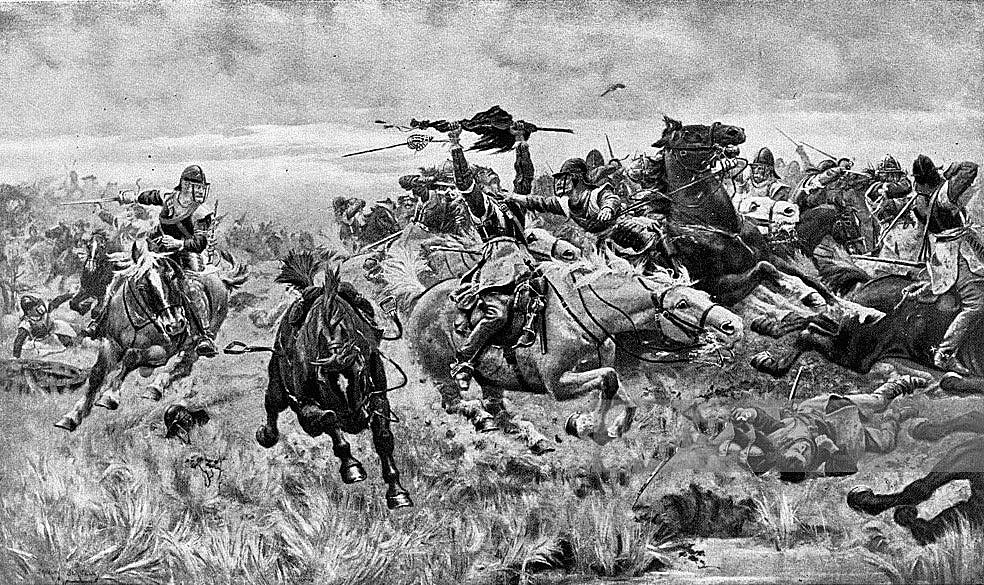
Cromwell’s own division had a hard pull of it, for they were charged by Rupert’s bravest men both in front and flank, they stood at their swords point a pretty while, hacking (at) one another but at last (it so pleased God) he broke through them, scattering them before him like a little dust.
The fight between Rupert and Cromwell’s cavalry was brutal and for a long time remained in the balance with Cromwell himself being wounded in the neck by a musket ball that barely missed an artery and led to him having to be taken from the field. He soon returned to rally his men, but the fight was only decided in Parliaments favour when David Leslie ordered the Scottish Reserve to support Cromwell’s Ironsides. Outnumbered and outflanked Rupert’s cavalry were forced to flee. Separated from his men Prince Rupert was made to hide out in a bean field stripping the insignia of rank from his shoulders to avoid recognition and capture.
Rupert’s defeat early in the battle meant that he was thereafter unable to influence the outcome of the battle with catastrophic results for the Royalist cause.
But the disaster on the Royalist right-flank was not yet being reflected elsewhere on the battlefield. On the left the attack of Fairfax’s cavalry had been impeded and slowed by the ditch and under heavy musket fire their formation began to come apart. When Lord Goring’s cavalry launched a counterattack, they fled the field and like Rupert before him Fairfax too tore of his insignia of rank to avoid capture.
Even so, the momentum remained with Parliament and the Royalists had been unable to halt the advance of their centre but in traversing the drainage ditch they too fell into disarray. Witnessing this Lord Eythin ordered the Royalist second line to attack through the gaps that were appearing in the Allied formation. So furious was their attack that the Allied front line was quickly overwhelmed, and panic began to set in as a number of Scottish Regiments fled the field. The sight of this and the behaviour generally of some of the Scottish troops at Marston Moor appalled the watching Oliver Cromwell and left him with a lasting contempt for the commitment, valour, and otherwise of the Scottish soldier.
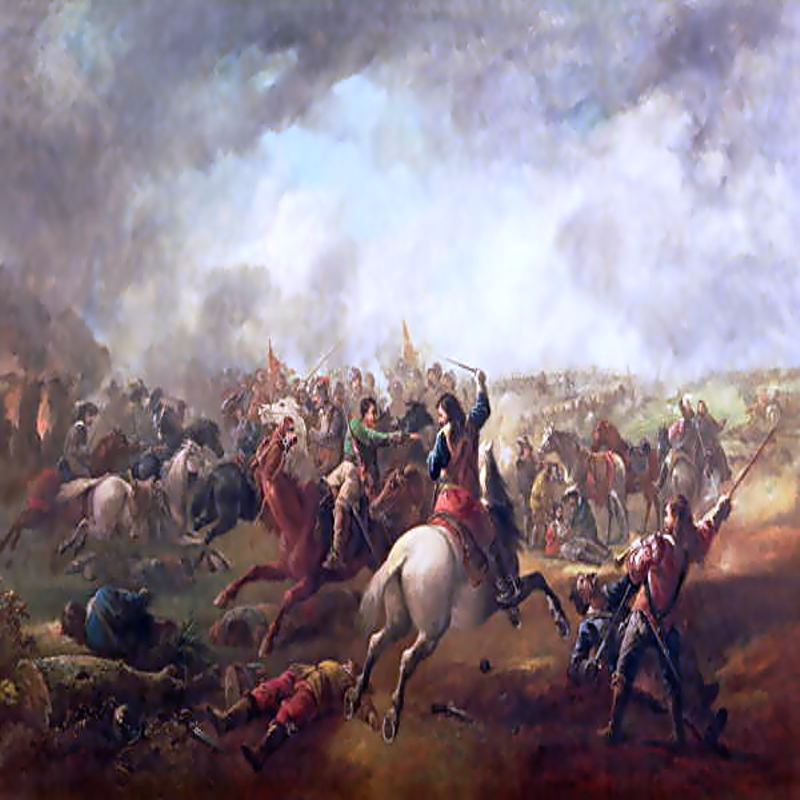
As the Allied centre began to break apart it seemed to many that the battle was lost and Lord Leven, Lord Fairfax, and temporarily at least the Earl of Manchester all fled the field, but it was to be the resolution of two Scottish Regiments under the command of Lord Maitland and the Earl of Lindsay that were to rescue the situation. They held their ground providing the time for the disordered regiments to be reorganised and the Earl of Manchester and his troops to return.
Lesley and Cromwell were informed of the near disaster that occurred on the left by Sir Thomas Fairfax who had managed to fight his way over to the other flank. With no time to lose Cromwell rallied his cavalry to charge the Royalist left. Lord Goring who was still engaged with the Allied infantry had no time to organise a defence and was quickly overwhelmed. With the Royalist cavalry swept from the field on both flanks their centre was now in danger of being surrounded and their troops began to flee the field. Only the 600 men of the Marquess of Newcastle’s Regiment of Whitecoats stood firm behind a ditched enclosure in the hope of buying time for an ordered withdrawal but with no one in command of the situation this was to prove impossible.
The Whitecoats refused to surrender despite demands to do so and had to endure repeated volleys of musket fire to which they had no effective answer. Even so, it wasn’t until cannon was brought up that that they at last threw down their arms by which time there was barely 30 of them left standing.
By the time the fighting ceased the battlefield was in darkness and a true accounting of what had occurred would not be known until the morning, but it transpired to be a comprehensive defeat for the Royalist Army. They had lost around 4,500 men killed and wounded with a further 1,500 captured along with all their baggage and guns. The Allied Army was to report only 333 killed and 500 wounded but the intensity of the fighting makes this figure seem implausibly low and appears to be a deliberate attempt to propagate the idea that such a comprehensive victory could only have been ordained by God.
Search parties were despatched by both sides to try and find Prince Rupert who had not been seen since early in the battle. The Royalists believed that he had most likely been killed and that they were searching for his corpse. As it was the descent of darkness had provided the cover for him to leave his place of hiding and re-join what remained of the Royalist forces of his own account and he quickly set about re-organising the shattered army into an effective fighting force of around 5,000 men.
The Marquess of Newcastle fearing that he would be blamed for the defeat and not willing to endure the ridicule of the Court the following day rode to Scarborough where abandoning the King’s cause, he took ship for Hamburg. It has been estimated that he had spent most of his fortune, around £1 million in raising and equipping the army he now left to its fate.
With the loss of Newcastle’s support and the city of York once more under siege (it was to surrender on 16 July) Rupert decided against rallying stragglers and recruiting more troops believing that his army would be best served with the King in the South. The North of England was lost to the Royalists for the duration of the conflict the consequences of which would be felt on the field of Naseby the following year.
Rupert again skilfully evaded the larger Parliamentary Army in pursuit of him in re-joining the King at Worcester but the recriminations at Court were great. His reputation for invincibility had been shattered and his enemies wanted him removed from command. They said he had squandered his army in a reckless assault upon superior forces when his remit to relieve the city of York had already been achieved. He defended himself with the King’s letter which he claimed had ordered him to take the fight to the enemy. The criticism hurt him deeply and he was to keep the King’s letter on his person for the rest of his life.
Aware of his own role in the disaster and that he could not entirely be cleared of blame Charles supported his nephew and Rupert remained in command of the army. In any case there was no one more able with which to replace him and the success achieved thus far had been largely down to him. The accusation of recklessness could not in any case be substantiated and in truth rather than being reckless Rupert had in fact paid the price for being uncharacteristically cautious. He had listened to the concerns of others and in doing so disregarded his own instincts and had hesitated to act when he should have done so. It was the first time he had ever displayed this weakness and he would never do so again.
Tagged as: Tudor & Stuart, War
Share this post:





